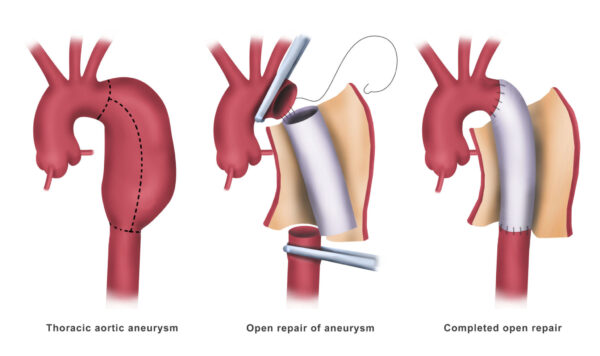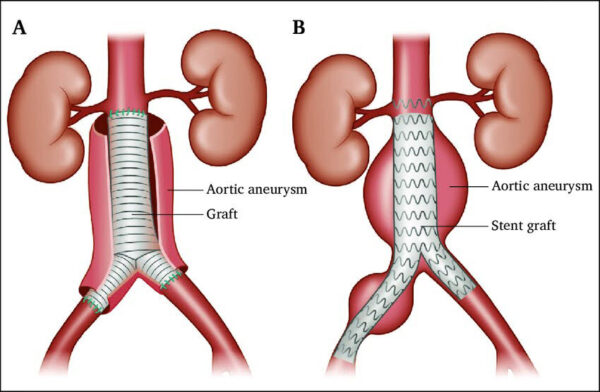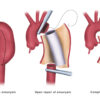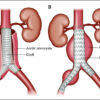Description
Familiarity with treatment
Aortic aneurysm repair involves surgical or endovascular techniques aimed at addressing weakened areas in the aorta, the body’s main artery, to prevent potential rupture or other serious complications.
Here are some key points regarding aortic aneurysm repair:
- Surgical Repair: Traditional open surgical repair involves making an incision in the chest or abdomen to access the aorta and replace the weakened section with a synthetic graft. This procedure typically requires a longer recovery period.
- Endovascular Aneurysm Repair (EVAR): EVAR is a minimally invasive alternative to open surgery. It involves inserting a stent graft through small incisions in the groin and guiding it to the site of the aneurysm using imaging techniques. The stent graft reinforces the weakened area of the aorta, reducing the risk of rupture.
- Risks and Benefits: Both surgical and endovascular repair methods have their own set of risks and benefits. Factors such as the size and location of the aneurysm, as well as the patient’s overall health, influence the choice of repair technique.
- Preoperative and Postoperative Care: Patients undergoing aortic aneurysm repair require thorough preoperative evaluations to assess their overall health and suitability for surgery. Postoperative care involves monitoring for potential complications and following a structured recovery plan.
- Lifestyle Modifications: After aortic aneurysm repair, patients may need to make lifestyle modifications, such as adopting a heart-healthy diet, engaging in regular exercise, and quitting smoking, to promote long-term cardiovascular health.
- Follow-up Care: Regular follow-up appointments with healthcare providers are crucial to monitor the repaired aorta, manage any lingering symptoms, and address any concerns that may arise during the recovery period.
Who is it suitable for?
Aortic aneurysm repair is a medical procedure aimed at treating an aortic aneurysm, which is a bulge in the aorta, the body’s main artery. The suitability for aortic aneurysm repair depends on several factors, including the size and location of the aneurysm, the overall health of the patient, and the presence of symptoms.
Suitability Criteria
- Aneurysm Size: Aneurysms that are large (typically over 5.5 centimeters in diameter) are often considered suitable for repair to prevent the risk of rupture. Smaller aneurysms may also be repaired based on the patient’s specific situation.
- Growth Rate: Rapidly growing aneurysms, regardless of their size, may warrant repair to reduce the risk of rupture.
- Symptoms: Aneurysms that are causing symptoms such as back or abdominal pain, or those that are pressing on other organs, may require repair.
- Overall Health: The patient’s overall health and ability to undergo surgery are crucial factors in determining suitability for aortic aneurysm repair.
- Location of the Aneurysm: The location of the aneurysm within the aorta can also influence the suitability for repair.
Contraindications
While aortic aneurysm repair can be beneficial for many patients, there are certain contraindications, including:
- Advanced age and poor overall health, which may increase the risks associated with surgery.
- Presence of other severe medical conditions that make surgery risky.
- Small aneurysms that are not actively growing or causing symptoms may be managed through monitoring rather than immediate repair.
Who is it not suitable for?
While aortic aneurysm repair can be a beneficial treatment for many individuals, there are circumstances in which the procedure may not be suitable. It’s important to consider the following factors when determining if a patient is not a suitable candidate for aortic aneurysm repair.
Contraindications
- Advanced Age and Poor Overall Health: Patients who are of advanced age and in poor overall health may not be suitable candidates for aortic aneurysm repair. The risks associated with surgery may outweigh the potential benefits in such cases.
- High Surgical Risk: Individuals with a high risk of surgical complications due to underlying health conditions or other factors may not be suitable for aortic aneurysm repair.
- Small Aneurysms with Low Risk of Rupture: Small aneurysms that are not actively growing and have a low risk of rupture may not require immediate repair. In such cases, close monitoring may be a more suitable approach.
- Presence of Severe Medical Conditions: Patients with severe medical conditions that make surgery risky may not be suitable candidates for aortic aneurysm repair.
- Patient Preference: Some patients may choose not to undergo aortic aneurysm repair due to personal preferences or other considerations. In such cases, alternative management options may be explored.
Advantages
Repairing an aortic aneurysm can offer several advantages, especially in the context of preventing potential life-threatening complications. Here are some of the key advantages of aortic aneurysm repair:
- Prevention of Rupture: Repairing an aortic aneurysm can prevent the risk of rupture, which is a potentially fatal complication. Rupture of an aortic aneurysm can lead to severe internal bleeding and shock.
- Improved Long-Term Survival: Aortic aneurysm repair, particularly for larger aneurysms, has been shown to improve long-term survival rates, reducing the risk of mortality associated with untreated aneurysms.
- Reduced Risk of Dissection: Repairing an aortic aneurysm can reduce the risk of dissection, where the layers of the aortic wall separate. Aortic dissection can lead to life-threatening complications and requires emergency intervention.
- Symptom Relief: For individuals with symptoms related to the aneurysm, such as chest or back pain, repair can provide relief and improve overall quality of life.
- Prevention of Compression: Large aortic aneurysms can compress adjacent structures, leading to symptoms such as difficulty swallowing or breathing. Repair can alleviate these symptoms by relieving the compression.
- Preventive Approach: Repairing an aortic aneurysm is a proactive measure that addresses the underlying issue, reducing the need for emergency interventions and associated risks.
- Reduced Anxiety: For individuals living with an aortic aneurysm, repair can alleviate the anxiety and stress associated with the potential risks and uncertainties of an untreated aneurysm.
Complications
Aortic aneurysm repair, whether through surgical or endovascular procedures, can be associated with certain complications. It’s important for individuals considering or undergoing these procedures to be aware of potential risks. Here are some common complications associated with aortic aneurysm repair:
- General Surgical Risks: Both open surgical repair and endovascular aneurysm repair carry inherent surgical risks, such as bleeding, infection, and adverse reactions to anesthesia.
- Endoleak: This is a complication specific to endovascular aneurysm repair. It occurs when blood leaks into the aneurysm sac after the placement of the stent graft. Endoleaks may require additional procedures to address and prevent potential expansion of the aneurysm.
- Migration or Endograft Movement: In endovascular repair, the stent graft used to reinforce the weakened aortic wall may migrate or move from its intended position. This can lead to inadequate aneurysm exclusion and potential complications.
- Aneurysm Rupture: Although the goal of repair is to prevent rupture, there is a small risk of rupture during or after the procedure, particularly in cases where the aneurysm was fragile or the repair was not fully successful.
- Organ or Tissue Ischemia: During aortic aneurysm repair, there is a risk of reduced blood flow to organs or tissues near the aorta, which can lead to ischemia (lack of oxygen) and potential organ damage.
- Spinal Cord Ischemia: In some cases, aortic aneurysm repair can lead to reduced blood flow to the spinal cord, resulting in spinal cord ischemia and potential neurological complications.
- Kidney Complications: The repair procedure can impact blood flow to the kidneys, potentially leading to kidney damage or dysfunction.
- Reintervention: Some patients may require additional procedures or interventions following aortic aneurysm repair due to complications or the need for ongoing management of the repaired aorta.
- Long-Term Surveillance: Following repair, individuals may require ongoing surveillance, as there is a risk of new aneurysm formation or changes in the repaired aorta over time.
Previous care
Before undergoing aortic aneurysm repair, several steps are typically taken to ensure that the patient is well-prepared for the procedure and has the best possible outcome. Here are some key aspects of preoperative care for aortic aneurysm repair:
- Comprehensive Medical Evaluation: Patients undergo a thorough medical evaluation to assess their overall health and identify any preexisting conditions that could affect the surgery or recovery. This evaluation often includes physical examinations, imaging tests, and laboratory work.
- Cardiovascular Assessment: Given the nature of aortic aneurysms, a comprehensive assessment of the patient’s cardiovascular health is essential. This may involve tests such as electrocardiograms (ECG), echocardiograms, and stress tests to evaluate heart function and identify any potential risks related to the cardiovascular system.
- Imaging Studies: Advanced imaging studies, such as computed tomography (CT) scans or magnetic resonance imaging (MRI), are conducted to precisely visualize the size, shape, and location of the aortic aneurysm. These images help the surgical team plan the repair procedure.
- Medication Review: Patients are typically asked to provide a complete list of medications, including prescription drugs, over-the-counter medications, and supplements. Some medications may need to be adjusted or temporarily discontinued in the lead-up to the surgery.
- Smoking Cessation: Smoking can significantly increase the risk of complications during and after aortic aneurysm repair. Patients who smoke are often advised to quit several weeks before the surgery to improve their outcomes and reduce the risk of postoperative complications.
- Nutritional Support: In some cases, patients may receive guidance on diet and nutrition to optimize their overall health before the surgery. This may include recommendations for a heart-healthy diet to support cardiovascular function.
- Patient Education: Patients and their families are provided with detailed information about the upcoming procedure, including what to expect before, during, and after the surgery. This education may cover topics such as postoperative care, potential complications, and anticipated recovery timelines.
- Anesthesia Consultation: Patients undergo a preoperative evaluation with an anesthesiologist to discuss anesthesia options, address any concerns, and ensure that the patient is prepared for the anesthesia-related aspects of the surgery.
- Emotional Support: Recognizing that undergoing surgery can be stressful, patients may receive emotional support and counseling to address any anxiety or concerns they may have about the procedure.
- Logistical Planning: Patients may receive guidance on logistical matters such as hospital admission procedures, transportation to and from the hospital, and postoperative care arrangements.
Aftercare
The postoperative care following aortic aneurysm repair is crucial for ensuring optimal recovery and long-term well-being. Here are key aspects of aftercare for individuals who have undergone aortic aneurysm repair:
- Monitoring in the Intensive Care Unit (ICU) or Step-Down Unit: After the procedure, patients are typically monitored closely in the ICU or a step-down unit, where their vital signs, pain management, and overall condition are carefully observed.
- Pain Management: Effective pain management is essential for patient comfort and recovery. Healthcare providers will assess and address the patient’s pain levels using appropriate medications and techniques.
- Activity and Movement: Patients are gradually encouraged to engage in light activity and movement as tolerated. Physical therapy may be initiated to help regain strength and mobility.
- Monitoring for Complications: Healthcare providers closely monitor for potential complications, such as bleeding, infection, or issues related to the repaired aorta, and take prompt action if any concerns arise.
- Medication Management: Patients will receive specific instructions regarding medications, including those aimed at preventing blood clots, managing pain, and addressing other postoperative needs. It’s important to adhere to the prescribed medication regimen.
- Dietary Guidance: Patients are typically provided with dietary guidance to support their recovery and overall cardiovascular health. This may include recommendations for a heart-healthy diet and fluid intake.
- Wound Care: Patients and caregivers receive instructions on how to care for any surgical incisions or wound sites. This may involve keeping the incision area clean and dry, watching for signs of infection, and following specific wound care protocols.
- Follow-up Appointments: Patients are scheduled for follow-up appointments with their healthcare providers to monitor their healing progress, assess their overall condition, and address any lingering concerns or questions.
- Lifestyle Modifications: Patients may receive guidance on making lifestyle modifications, such as incorporating regular exercise, quitting smoking, and adopting a heart-healthy lifestyle to promote long-term cardiovascular health.
- Emotional Support: Patients and their families may benefit from emotional support and counseling to address any emotional or psychological aspects related to the procedure and recovery.
- Long-Term Surveillance: Following aortic aneurysm repair, individuals often require long-term surveillance to monitor the repaired aorta, assess for any potential complications, and manage ongoing cardiovascular health.
Only logged in customers who have purchased this product may leave a review.




Reviews
There are no reviews yet.